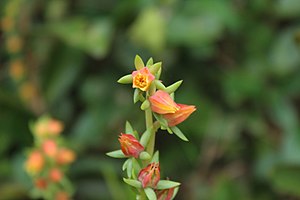Echeveria bicolor
| Echeveria bicolor | ||||||||||||
|---|---|---|---|---|---|---|---|---|---|---|---|---|

Echeveria bicolor |
||||||||||||
| Systematics | ||||||||||||
|
||||||||||||
| Scientific name | ||||||||||||
| Echeveria bicolor | ||||||||||||
| ( Kunth ) E. Walther |
Echeveria bicolor is a species of Echeveria ( Echeveria ) in the thick-leaf family(Crassulaceae).
description
Echeveria bicolor forms little branched plants, the shoots of which develop lengths of 50 centimeters and more. The shoots reach a diameter of about 9 to 12 millimeters. The absent-minded, inverted lanceolate to spatulate leaves are 7 inches long and 2.5 inches wide. The upper side of the leaves is concave or furrowed, it is sometimes a little glaucous and glossy green.
The inflorescence is formed from grapes. The flower stalk is 3 to 4 millimeters long. The widely spread sepals are green and about 8 millimeters long. The corolla is about 8 to 10 millimeters long and has a diameter of 7 to 9 millimeters at the throat. It is colored reddish yellow.
The number of chromosomes is 2n = 42, rarely 84.
Distribution and systematics
Echeveria bicolor is common in Venezuela and Colombia .
It was first described in 1823 as Sedum bicolor by Karl Sigismund Kunth . Edward Eric Walther placed the species in the genus Echeveria in 1935 . The following synonyms exist : Sedum bicolor Kunth , Echeveria bracteolata Link & al. , Cotyledon bracteolata (Link & al.) Baker , Cotyledon subspicata Baker , Echeveria subspicata (Baker) A. Berger , Echeveria bicolor var. Subspicata (Baker) E. Walther, and Echeveria venezuelensis Rose .
A distinction is made between the following varieties :
- Echeveria bicolor var. Bicolor ; a very variable species. In the west of Venezuela there are short-stemmed forms that form a transition to Echeveria recurvata . The Echeveria subspicata listed above as a synonym may be an independent species from Colombia.
- Echeveria bicolor var. Turumiquirensis Steyermark ; forms shorter inflorescences than the stem species, the flowers are more densely packed and are deep red in color.
proof
literature
- Urs Eggli (ed.): Succulent lexicon. Crassulaceae (thick leaf family) . Eugen Ulmer, Stuttgart 2003, ISBN 3-8001-3998-7 , pp. 109 .
Individual evidence
- ↑ Echeveria bicolor at Tropicos.org. In: IPCN Chromosome Reports . Missouri Botanical Garden, St. Louis
- ↑ Nova genera et species plantarum quas in peregrinatione ad plagam aequinoctialem orbis novi collegerunt Bonpland et Humboldt , Paris, Volume 6, 1823, p. 45. online
- ^ Cactus and Succulent Journal . Volume 7, 1935, p. 39. online ( page no longer available , search in web archives ) Info: The link was automatically marked as defective. Please check the link according to the instructions and then remove this notice.